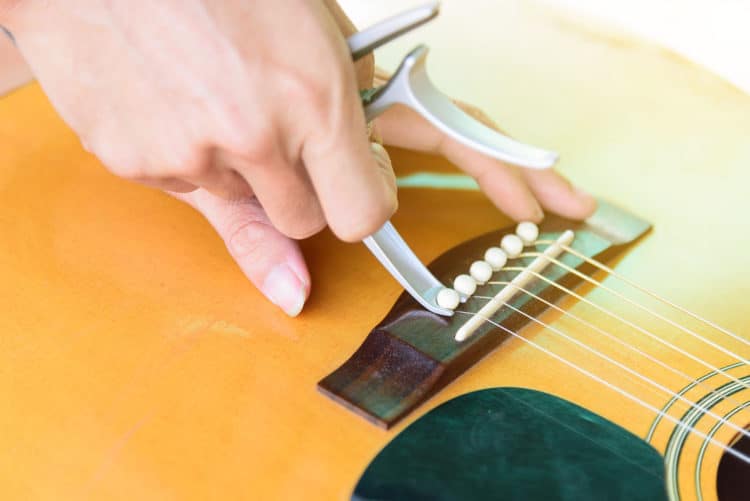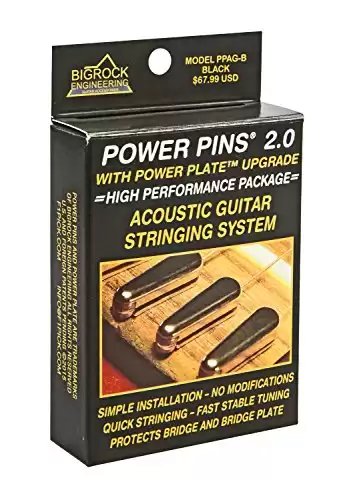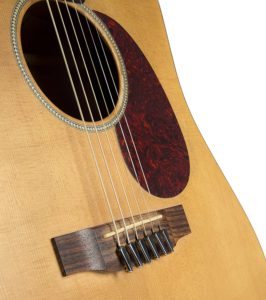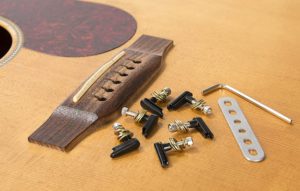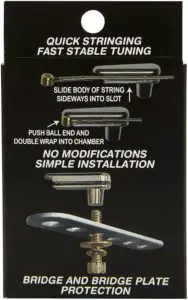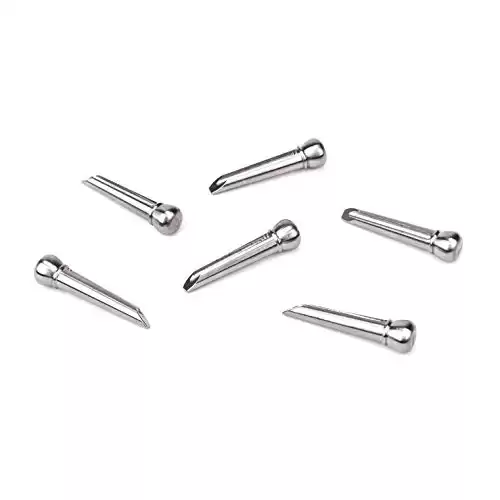You’ve started to put new strings on your acoustic guitar. That’s when one of the bridge pins gets stuck. Is it time for a replacement, or is there a more significant issue to address?
If the pins get stuck frequently, there could be a problem with the bridge plate. It’s also important to remember that this component is considered a consumable product. They eventually wear out, which means they’ll finally break.
That’s why it’s crucial to inspect your bridge pins after every string change. If your plate starts wearing out, the results could be catastrophic for your instrument.
When Should I Replace My Guitar Bridge Pins?
Whenever you see wear on the bridge pins for a guitar, that’s a great sign that indicates it is time to replace them. If they pop out whenever you replace the strings and try to tune the instrument, there’s enough wear on them to warrant a replacement. The other time to consider an update is when the strings sound dull or lack sustain.
Most guitars that feature steel strings use bridge pins to hold them against the bridge and bridge plate.
You can find the pins in several different sizes and material choices. Although bone or plastic are typically the most popular, wood and brass have become viable options in recent years. Older guitars might even have their original ivory pins in place.
The goal of the bridge pins isn’t to secure the guitar strings to the bridge. Their job is to hold the ball end against the bridge plate, preventing it from launching out during the tuning process.
If you’ve ever broken a string on an acoustic guitar, you know how scary it can be to have that end come flying at your face.
When a bridge pin fails, you’ve got that ball coming at you instead. That’s why regular inspections are necessary.
It keeps the guitar playing and you safe.
What Are the Different Pros and Cons of Bridge Pin Materials?
When choosing what bridge pins to use, you’ll discover that several different material options are available to consider.
If you have an entry-level guitar, the pins are likely made of plastic. In the mid-range instrument profiles, you’ll find bone and wood available.
Brass serves as an alternative to ivory. Today, it is virtually impossible to find a direct replacement for ivory guitar pins, so most players will want to see a different option.
It might not even be legal for you to obtain ivory guitar pins.
Here are the different pros and cons to consider for each material type so that you can get the appropriate pins for your instrument.
| Material Type | Pros of the Guitar Pin Material | Cons of the Guitar Pin Material |
| Plastic Guitar Pins | – It’s affordable and readily available at most music stores and online shops. – Replacement techniques are simple and straightforward. – Delivers a consistent performance when updating a guitar. | – Breaks easier than the other pin materials. – Does not provide enhancement options for a guitar’s tone. – Even high-quality plastics can look like a cheap update on some instruments. |
| Wood Guitar Pins | – Available for purchase online and at most local music stores. – Installing wood pins creates sustain and tone improvements for many acoustic guitars. – Multiple tonewoods are available to consider, including ebony and rosewood. | – Rosewood pins are getting harder to find because of import restrictions. – Some pins require the bridge to get reamed before they’ll install correctly. – Exotic woods can be challenging to find as a direct replacement option for some guitars. |
| Brass Guitar Pins | – Once you replace your guitar pins with a brass alternative, they’ll last forever. – It delivers extra brightness, which works well for an acoustic with excessive bass. – After the installation, the metal looks great with the other instrument elements. | – The extra brightness from the metal can overwhelm the tone and character of some instruments. – Almost every guitar requires bridge reaming to have this option work. – Even though it is growing in popularity, these pins are still somewhat difficult to find in local shops. |
| Bone Guitar Pins | – This material is a popular choice because it increases the sustain of virtually any acoustic guitar. – Brighter tones become possible without altering the attack profile of each note. – Delivers a longer lifespan option than plastic or wood for most musicians. | – Could require bridge modification to ensure the pins work as intended. – Authentic bone pins are sometimes hard to find since high-quality plastics can look the same. – Variations in density and shape are more likely with this material. |
| Ivory Guitar Pins | – Several legal options have become available in recent years, including pins made from wooly mammoth fossils. – Once installed, a noticeable increase to the sustain is heard. – The product delivers warm tones while looking fantastic on an instrument. | – Genuine ivory is difficult to find in the marketplace because of import and export restrictions. – Ethical implications about how elephants and walruses are hunted for this material must be considered. – Density ratings are highly variable, even within a standard set of six. |
When I play an acoustic guitar, my preference is to use ebony bridge pins. I prefer the warmth and note-shaping characteristics of the wood, especially in combination with the materials found in my No. 1 guitar.
If I had to choose a second option, I’d go with the brass pins. The longevity of that investment is inviting, especially for my acoustics that tend to have the lower frequencies overwhelm what the midrange attempts to deliver when strumming.
Unless there is no other option, I try to avoid plastic guitar pins. They are appropriate for beginners on an entry-level guitar, but they tend to break faster than the other materials. I’d rather spend my time practicing or playing instead of swapping out the pins.
■ Why Is It Necessary to Replace the Bridge Pins?
Bridge pins are meant to handle a heavy load. Even the most robust materials (except metals) wear out with frequent play.
If you’re using a guitar four or five times per week, the bridge pins probably need replacing once or twice per year.
When the pins wear out, it allows the ball end of the acoustic string to travel into the bridge.
Not only does this action increase the risk of it dislodging and flying free, but it can also cause the bridge plate to crack, dislodge, or function incorrectly.
If the bridge plate cracks on an acoustic guitar, the bridge can do the same. In severe cases, it might even pull away from the top or cause the braces to fail.
Some pins get stuck inside the bridge when they fail. If that happens, you can remove it by pushing the string down further to dislodge the pin so that it will come out.
Should that effort fail, it’ll become necessary to force the pins out by pushing it upward from inside the instrument.
How to Replace Bridge Pins on an Acoustic Guitar
If you have broken bridge pins, you’ll need to remove them and clean the area by taking all the parts out of the instrument.
That result is possible by following these steps.
- Stuck pins require the strings to be disconnected from the ball. After loosening them, you can snip them away close to the bridge. Do not cut strings under tension, as this action could cause an injury.
- Use pliers while putting your arm inside the guitar. Gently tap on the stuck pin from the underside with the tool. In most situations, it should start sliding out with a couple of taps.
- For pins that are stubborn, use a peg remover to support the pliers.
Some people like to use the pliers to pull at the stuck pins from the outside. Although that effort can produce the intended result, it also significantly increases the risk of creating a loose bridge.
Even with your best efforts, stuck pins tapped from the underside can also loosen a bridge. When that happens, you’ll need to fix it to ensure appropriate cleaning occurs.
In most cases, there’s enough glue available to have it get tightened naturally. You’ll need to use a heating pad on the top to liquefy the adhesive underneath.
Once it becomes pliable, you can restore its position. Be careful here because peeling it away could damage the finish of your guitar.
If there isn’t enough adhesive available to restore the bridge’s position, it’ll need to come out and get glued a second time. After removing it, apply an appropriate adhesive.
In both circumstances, it helps to use a clamp on the bridge to secure it. You’ll likely need to have the adhesive cure overnight before finishing the restoration or cleaning work.
If excess glue appears while clamping, remove it with a damp paper towel or a lint-free cloth to achieve a successful result.
Best Replacement Pins to Use for Acoustic Guitars
When your acoustic guitar pins are beyond repair, it is necessary to secure a replacement.
Although it’s easy to run down to the local music shop to grab something, there might not be the right material, color, shape, or size available for what you want to accomplish with this update.
Here are the best replacement pins I’ve used over the years with my acoustics collection.
Each one has some specific strengths it brings to the playing equation and I’d love to help you find the right one for you.
- Attaches Beneath the Guitar Bridge Using a Threaded Brass Bridge Pin
- Strings Mount Horizontally Through the Tops of the Included Matching Brass Pins
- Comes with Detailed, Easy-to-Follow Installation Instructions
1. JLD Acoustic Guitar Brass Pins
When the soundboard becomes a problem with an acoustic I love, this device and the brass pins are what I get to make things right.
When installed correctly, it applies pressure against the tailblock to flatter the board. The strings mount horizontally through the tops, providing better brightness and attack.
If your guitar has a small sound hole, it might not be possible to tighten the nuts on the brass pins with this option.
I tend to use it for my classical instruments or the oversized dreadnoughts in my collection.
- Black Chrome Set /w Power Plate Upgrade
- Offers Improved Tone and an Amplified Sound
- It Allows for Easier Restringing, and Faster Tuning
- Extremely Durable
2. BigRock Engineering Power Pins 2.0
This patented system protects the bridge plate and bridge from the tension delivered by the strings while improving the guitar’s overall sound.
You don’t need to modify the instrument to install this product. Once you have them in place, they can stay there permanently.
I’ve found that tuning and re-stringing are a lot easier when using Power Pins 2.0. Since it reduces the breaking angle of the strings, the action becomes a touch softer.
The product is made from an aluminum alloy to ensure corrosion resistance. It takes a bit to install, but it is definitely worth the effort.
- Great Tone
- Incredible, Strong Sustain
- 6 Pins
- Made in USA
3. D’Addario Titanium Bridge Pins
Although brass guitar pins tend to be the most popular choice for an upgrade to metal, I’ve fallen in love with these beautiful titanium alternatives from D’Addario.
They deliver an incredible sustain that you need to hear to believe.

It only takes a couple of minutes to install these new guitar pins. You’ll see noticeable upgrades compared to plastic and ceramic options right away.
When put up next to bone, I’ve found that the consistency is much better.
Do I Need to Replace My Bridge Pins Today?
Using high-quality bridge pins can improve a guitar’s tone. When they fit correctly, the instrument can perform as intended. The bridge plate requires an ongoing inspection to ensure structural integrity, providing stability for the playing experience. Repair is not an option if that component cracks.
If it looks like your bridge pins are wearing out, it’s time to inspect the bridge plate. If it cracks, the entire component must be replaced to restore a guitar’s functionality.
I’ve found a small mirror helps to see this part to ensure it remains intact. If you don’t want to mess with this issue, a local luthier can provide a professional evaluation and inspection without being overly expensive.
Bridge pins might be a small part, but they help to deliver a big sound. That’s why updating them with better materials is your ticket to less maintenance and better playing opportunities.

